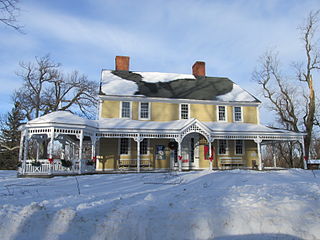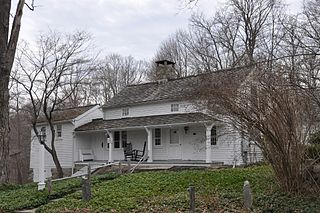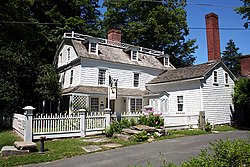
Cass Gilbert was an American architect. An early proponent of skyscrapers, his works include the Woolworth Building, the United States Supreme Court building, the state capitols of Minnesota, Arkansas, and West Virginia, the Detroit Public Library, the Saint Louis Art Museum and Public Library. His public buildings in the Beaux Arts style reflect the optimistic American sense that the nation was heir to Greek democracy, Roman law and Renaissance humanism. Gilbert's achievements were recognized in his lifetime; he served as president of the American Institute of Architects in 1908–09.

Redding is a town in Fairfield County, Connecticut, United States. The population was 8,765 at the 2020 census. The town is part of the Western Connecticut Planning Region.

Ridgefield is a town in Fairfield County, Connecticut, United States. Situated in the foothills of the Berkshire Mountains and on the New York state border, Ridgefield has a population of 25,033 as of the 2020 census. The town is part of the Western Connecticut Planning Region. The town center, which was formerly a borough, is defined by the U.S. Census Bureau as a census-designated place. The town was settled then quickly incorporated by 1709.

Old Salem is a historic district of Winston-Salem, North Carolina, United States, which was originally settled by the Moravian community in 1766. It features a living-history museum which interprets the restored Moravian community. The non-profit organization began its work in 1950, although some private residents had restored buildings earlier. As the Old Salem Historic District, it was declared a National Historic Landmark (NHL) in 1966, and expanded fifty years later. The district showcases the culture of the Moravian settlement in the Province of North Carolina during the colonial 18th century and post-statehood 19th century via its communal buildings, churches, houses and shops.

Weir Farm National Historical Park is located in Ridgefield and Wilton, Connecticut. It commemorates the life and work of American impressionist painter J. Alden Weir and other artists who stayed at the site or lived there, to include Childe Hassam, Albert Pinkham Ryder, John Singer Sargent, and John Twachtman.

Silvermine is an unincorporated community in Fairfield County, Connecticut, United States that extends along the Silvermine River, across three southwestern Connecticut towns: Norwalk, New Canaan and Wilton.

The Old Constitution House is a historic house at 16 North Main Street in Windsor, Vermont. It is the birthplace of the Vermont Republic and the Constitution of the State of Vermont. A mid-18th century building built in a simple Georgian architectural style, the Old Constitution House was originally called the Windsor Tavern, and belonged to Elijah West at the time of the signing of the constitution. The house is a Vermont State Historic Site, and is administered by the Vermont Division for Historic Preservation. It is also listed on National Register of Historic Places, separately since March 11, 1971 as well as a part of the Windsor Village Historic District since April 23, 1975.

The Georgetown Historic District is a historic district which covers the central portion the village of Georgetown, Connecticut. The district includes parts of Georgetown in the towns of Redding, Weston, Wilton, and Ridgefield and consists of the former Gilbert & Bennett manufacturing plant, institutional housing built for the plant workers, other private homes, and the Georgetown business district.

The Ridgefield Center Historic District is part of the town of Ridgefield, Connecticut. It was listed on the National Register of Historic Places in 1984.

The Wilton Center Historic District in the town center area of Wilton, Connecticut, was established as a town historic district in 1970 and was listed on the National Register of Historic Places in 1992.

The Russell Corner Historic District of Princeton, Massachusetts encompasses a small 19th century commercial center that developed into a summer resort area by the early 20th century. Centered at the intersection of Merriam Road and Gregory Hill Road, the district includes fifteen contributing buildings on 124 acres (50 ha), which are predominantly residential in nature, and were mostly built before 1830. Some of the properties are found on East Princeton and Sterling Roads, and Bullock Lane. The district was listed on the National Register of Historic Places in 2006.

Lounsbury House, formerly known as Grovelawn and as the Ridgefield Veterans Memorial Community Center, is a historic house at 316 Main Street in Ridgefield, Connecticut. It is a two-story wood frame Classical Revival-style building that was built in 1895. Its design, by Charles Northrop, was an emulation of the Connecticut State Building exhibited at the 1893 Columbian Exposition, at the request of Governor Phineas C. Lounsbury, who attended the exhibition. It served as his family home. Lounsbury died in 1925, and his heirs gave the house to the town in 1945. The House and classic gardens now serve as a venue for weddings, corporate meetings, art gatherings, festivals and special events.

The Benedict House and Shop is a historic property at 57 Rockwell Road in Ridgefield, Connecticut. Built in 1740, the connected house and shop are among the oldest surviving buildings in the community. The shop is a particularly rare example of a cobbler's workshop of the 19th century. They are further notable for the sympathetic restoration they underwent at the hands of architect Cass Gilbert. The property was added to the National Register of Historic Places on December 4, 1998.

The Hugh Cain Fulling Mill and Elias Glover Woolen Mill Archeological Site is a 4.4-acre (1.8 ha) industrial archeological site in the eastern part of Ridgefield, Connecticut. It is the site of an early fulling mill established in 1770, and was an active industrial site until the turn of the 20th century. The site was listed on the National Register of Historic Places in 1985.

The Walker Tavern is a historic structure located at 11710 U.S. Route 12 in Cambridge Township in northwesternmost Lenawee County, Michigan. It was designated as a Michigan Historic Site on February 19, 1958, and was later the county's first property added to the National Register of Historic Places on January 25, 1971. The structure was incorporated into the Cambridge Junction Historic State Park and continues to serve as a museum and venue for various events.

The Seaside is a historic medical facility at 36 Shore Road in Waterford, Connecticut. It is nationally significant as the first institution designed for heliotropic treatment of children suffering from tuberculosis. Its buildings "comprise an exceptional collection of fully realized and generally well-preserved Tudor Revival-style institutional architecture", which were designed by Cass Gilbert. The property was listed on the National Register of Historic Places in 1995.

The Bauer Manor, also known as the Davenport House or Davenport Hotel, is a hotel located at 1280 U.S. Route 12 near the unincorporated community of Tipton in Franklin Township in northern Lenawee County, Michigan. It was designated as a Michigan State Historic State on May 18, 1971 and listed on the National Register of Historic Places on May 4, 2007.

The Kemp's Hotel is an historic American inn and tavern building that is located in Maxatawny Township, Berks County, Pennsylvania.

The Captain William Bull Tavern is a historic inn at 571 Torrington Road in Litchfield, Connecticut. It is part of the Tollgate Hill Inn and Restaurant, and is listed on the National Register of Historic Places. It is significant both as an excellent local example of Colonial architecture, and for its role in early architectural preservation efforts in the region.

S. Walker's Hotel, also known as the Brick Walker Tavern, is a former hotel/tavern located at 11705 US-12 in Cambridge Township, Michigan. It was listed on the National Register of Historic Places in 2007. The hotel is notable for its brick exterior and three-story height - most other surviving early brick tavern/hotel buildings in Michigan are two-story frame structures. The building is currently operated as an event space known as the "Brick Walker Tavern."
























